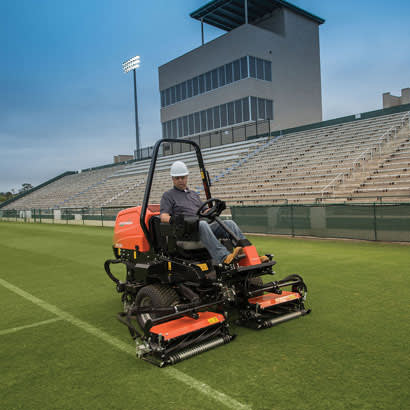
Before the sun rises and many of us begin our day, turf maintenance professionals around the United States have already arrived at work, adorned their personal protection equipment — safety glasses, hard hat, work gloves and safety shoes — and climbed into a piece of professional turf care equipment, buckling up to begin the meticulous task of maintaining their facilities. Without taking the proper precautions, it can be a dangerous endeavor, navigating uneven topography, inclines and obstacles to ensure every blade of grass receives the perfect cut. Wet turf affects traction, and trees with low-hanging branches can be abundant. Safety is always top of mind, not only for workers, but also for the manufacturers of mowing equipment.
Many models feature innovative technologies that offer increased stability and better visibility, and some models even have cutting reels that shift to safely handle tight turns and hard-to-reach areas without compromising quality of cut or productivity.
A Better Cut
Turf maintenance workers are often accustomed to driving a mower with a single, large cutting deck. A large cutting deck can accomplish the task more quickly, but often delivers a lower quality of cut. If an operator is using a mower on a contoured area with intricate landscaping, the operator will need to maneuver the cutting deck into the right position to avoid damaging the landscaping. This maneuver may result in the operator working at undesirable angles, losing stability and traction.
Technology now exists that enables operators to effortlessly shift all three cutting reels to either side of the mower, creating up to 18 inches of offset. This type of technology allows the operator to focus on mowing, rather than navigating around hazards and offers him or her the ability to cut every blade of grass before the mower drives over it, achieving a superior quality of cut. The technology allows operators to place the equipment further from an obstacle for increased safety, define where the reels are positioned, and ultimately increase productivity.
Stability Is Everything
Some professional turf equipment now provides a wider wheel base, or a shorter overall height. The goal is to lower the center of gravity and disperse the equipment’s weight more effectively. Mowers with a lower center of gravity help operators to feel more planted and stable on this mower, especially when operating the machine on a downhill slope.
Enhancing Ergonomics
There is a direct correlation between safety, productivity and ergonomics. In general, ergonomics is aimed at making the operator more comfortable when performing a repetitive task, resulting in that person feeling more confident on the unit and helping them to be more productive.
Depending on the task, a grounds maintenance worker may operate a mower for several hours at one time. Most new products offer an ergonomically contoured seat. While this is certainly beneficial, consider a unit equipped with a mechanical suspension, which delivers a smoother ride and reduces fatigue. Evaluating the seat position is also key. Some designs are in a more reclined position. While comfortable, this approach may require the worker to strain to reach the controls. The distance and angle of the steering column is also important. Is it easily adjusted? Does the operator need to slide around the steering column to enter or exit the mower, or can he or she easily stand up to get off the platform?
Finally, a critical safety consideration is the “three points of contact” rule. It’s important for the operator to always have three points of physical contact at all times. This can be achieved through a combination of properly positioned handles on the rollover protection system (ROPS), the steering column and steps. When looking for safe mowers, evaluate where the step points and handles are located. Will a smaller operator struggle to reach a ROPS handle? Are the steps on the mower equipped with grips, and do those steps have a ribbed surface or a tread plate?
Technology plays an important role in engineering mowers that work harder for the operator. The innovation offered today allows the worker to focus on achieving the perfect cut while staying safe.
Antony Alexander is a Product Manager for Jacobsen.

